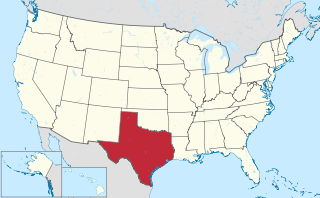
Caltha palustris, known as marsh-marigold and kingcup, is a small to medium size perennial herbaceous plant of the buttercup family, native to marshes, fens, ditches and wet woodland in temperate regions of the Northern Hemisphere. It flowers between April and August, dependent on altitude and latitude, but occasional flowers may occur at other times.

Physalis peruviana, a plant species of the genus Physalis in the nightshade family Solanaceae, has its origin in Peru. The plant and its fruit are commonly called Cape gooseberry, goldenberry, and physalis, among numerous regional names. The history of Physalis cultivation in South America can be traced to Inca Indians. It has been cultivated in England since the late 18th century, and in South Africa in the Cape of Good Hope since at least the start of the 19th century. Widely introduced in the 20th century, P. peruviana is cultivated or grows wild across the world in temperate and tropical regions.

Allium anceps, known as twinleaf onion and Kellogg's onion, is a species of wild onion native to the western United States. It is widespread in Nevada, extending into adjacent parts of California, Idaho, and Oregon. It grows in barren clay and rocky soils.

Blandfordia grandiflora, commonly known as Christmas bells is a flowering plant endemic to eastern Australia. It is a tufted, perennial herb with narrow, channelled, linear leaves and between two and twenty large, drooping, bell-shaped flowers. The flowers are red with yellow tips or sometimes entirely yellow. It is one of four species of Blandfordia known as Christmas bells, this one growing on the coast and ranges between Sydney in New South Wales and Fraser Island in Queensland.

Vaccinium stamineum, commonly known as deerberry, tall deerberry, squaw huckleberry, highbush huckleberry, buckberry, and southern gooseberry, is a species of flowering plant in the heath family. It is native to North America, including Ontario, the eastern and central United States, and parts of Mexico. It is most common in the southeastern United States.

Caltha leptosepala, the white marsh marigold, twinflowered marsh marigold, or broadleaved marsh marigold, is a species of flowering plant in the buttercup family. It is native to western North America from Alaska to New Mexico, where it grows in wet mountain habitats in alpine and subalpine regions. There are two general wild types of this species, one native to the interior and one that grows along the Pacific coast and coastal mountains, but these are not always treated separately.
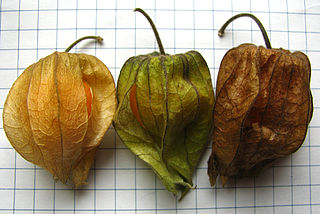
Physalis heterophylla, colloquial name clammy groundcherry, is a herbaceous plant that is a member of the family Solanaceae. It is native to North America, occurring primarily in the eastern United States and Canada. It is known to occur in all contiguous states except for Nevada and California. It is found mainly in habitats such as dry or mesic prairies, gravel hills and rises, sandy or rocky soils, and waste places such as roadsides.

Physalis longifolia, known by the common names common groundcherry, longleaf groundcherry, and wild tomatillo, is a species of flowering plant in the nightshade family, Solanaceae. It is native to North America, where it is native to eastern Canada, much of the continental United States, and northern Mexico. It has also been noted as an introduced species in other regions, including parts of the United States outside its native range. In some areas, such as California, it is an occasional noxious weed.
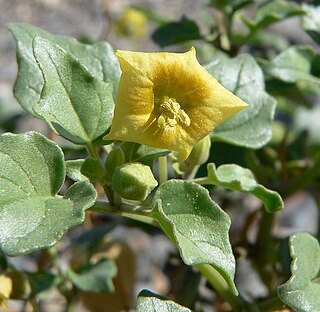
Physalis crassifolia is a species of flowering plant in the nightshade family known by the common names yellow nightshade groundcherry and thick-leaf ground-cherry. It is native to the southwestern United States and northern Mexico, where it can be found in rocky, dry desert and mountain habitat. This is a perennial herb producing a ridged, angular, branching stem approaching 80 cm long, taking a clumped, matted, or erect form. The fleshy oval leaves are 1 to 3 cm long and have smooth, wavy, or bluntly toothed edges. The herbage is glandular and coated in short hairs. The yellow flowers growing from the leaf axils are widely bell-shaped, vaguely five-lobed, and around 2 cm wide. The star-shaped calyx of sepals at the base of the flower enlarges as the fruit develops, becoming an inflated, angled lanternlike structure about 2 cm long, which contains the berry.
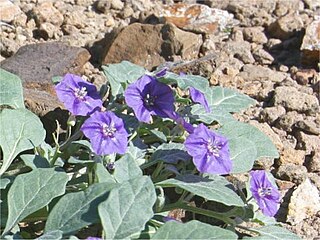
Quincula is a monotypic genus of flowering plants in the nightshade family, Solanaceae. The sole species it contains, Quincula lobata, is commonly known as Chinese lantern, lobed groundcherry, or purple groundcherry.

Physalis pubescens is a species of flowering plant in the nightshade family known by many common names, including husk tomato, low ground-cherry and hairy groundcherry in English, and muyaca and capulí in Spanish. It is native to the Americas, including the southern half of the United States, Mexico, Central and much of South America. It can be found elsewhere as an introduced species and sometimes a weed. It can grow in many types of habitat, including disturbed areas. This is an annual herb producing a glandular, densely hairy stem up to about 60 cm (24 in) in maximum height from a taproot. The oval or heart-shaped leaves are 3–9 cm (1.2–3.5 in) long and have smooth or toothed edges. The flowers blooming from the leaf axils are bell-shaped and about a centimeter long. They are yellow with five dark spots in the throats, and have five stamens tipped with blue anthers. The five-lobed calyx of sepals at the base of the flower enlarges as the fruit develops, becoming an inflated, ribbed, lanternlike structure 2–4 cm (0.79–1.57 in) long which contains the berry.
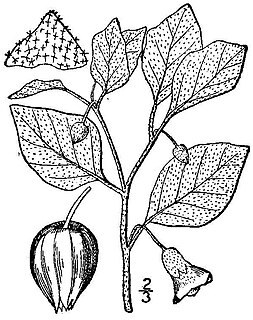
Physalis viscosa is a species of flowering plant in the nightshade family known by many common names, including starhair groundcherry, stellate ground-cherry and grape groundcherry in English, and arrebenta-cavalo, balãozinho, and camambú in Portuguese. It is native to South America, and it is known on other continents as an introduced species and sometimes a weed. It can grow in many types of habitat, including disturbed areas.

Blandfordia cunninghamii is one of four species of flowering plant commonly known as Christmas bells. It is a tufted, perennial herb endemic to the Blue Mountains and Illawarra regions of eastern Australia. It has long, narrow, linear leaves and between twelve and thirty large, drooping, cylindrical to bell-shaped red flowers with yellow tips.
Rhodolaena acutifolia is a plant in the family Sarcolaenaceae. It is endemic to Madagascar. The specific epithet acutifolia is from the Latin meaning "sharp-leafed".

Leucospermum prostratum is a trailing shrub of up to 4 m (13 ft) in diameter that has been assigned to the Proteaceae. It has alternately set, about 3 cm (1.2 in) long, lance-shaped, olive-colored, upright leaves, and produces sweetly scented, compact, hemispherical flower heads, with long styles sticking out far from the perianth tube, which jointly give the flower head the appearance of a pincushion. The fragrant flowers that can be found between July and December are initially yellow but turn orange when older. It is an endemic species restricted to the south coast of the Western Cape province of South Africa. Its common name is yellow-trailing pincushion.

Leucospermum erubescens is an evergreen shrub of up to 2 m high, with hairless, lancet-shaped to oval leaves with three to seven teeth near the tip of 7–8½ cm long and 1–2 cm wide, slightly asymmetric, oval flower heads of 5–6½ cm in diameter, and usually with four to eight clustered near the end of the branches, with initially yellow flowers, that change to deep crimson, from which long styles stick out, giving the flowerhead as a whole the appearance of a pincushion. It is called orange flame pincushion in English and oranjevlamspeldekussing in Afrikaans. It can be found in South Africa. Flowers may be found between August and January.
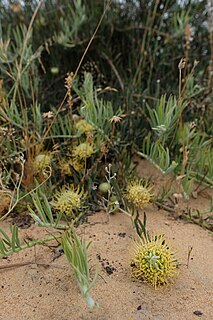
Leucospermum arenarium is a lax, evergreen shrub, with arching and drooping branches, that has been assigned to the family Proteaceae. It has loosely spaced, upright, greyish, narrowly egg-shaped to line-shaped leaves, mostly without teeth and flattened globe-shaped flower heads of 5–7 cm across, consisting of mostly creamy, seldom yellow flowers, that curve in the bud to the center of the head. From the center of the flowers emerge curved styles that jointly give the impression of a pincushion. The common name in English is Redelinghuys pincushion. It only occurs in a very small area in the Western Cape province of South Africa. It flowers between July and October. Unlike in related species the flowers are pollinated by hairy-footed gerbils and striped field mice.
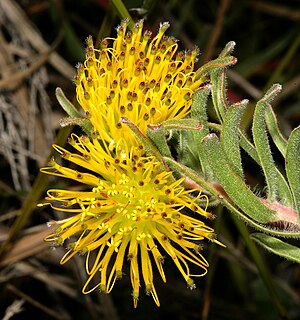
Leucospermum gracile is a low spreading shrub of 30–40 cm high and forms open mats of 1½ m (5 ft) in diameter, that is assigned to the family Proteaceae. It has reddish flowering stems, oblong to linear leaves of 2–4½ cm (0.8–1.8 in) long and 2–5 mm (0.08–0.20 in) wide, with one or three teeth. The initially yellow, later orange flower heads of 2½–3 cm (1.0–1.2 in) in diameter are flat-topped. The flower heads occur from July to October. From the flowers occur long styles with a slightly thicker tip, which together give the impression of a pincushion. It is called Hermanus pincushion in English. It naturally occurs in fynbos in the southern mountains of the Western Cape province of South Africa.

Mairia crenata is a perennial herbaceous plant of mostly 2–15 cm (1–6 in) high that is assigned to the daisy family. It has a woody rootstock of up to 5 cm (2 in) long, from which brown, fleshy roots develop. The five to eighteen, hard and leathery, spoon-shaped leaves are in one to three rosettes, have a distinct main vein, blunt or pointy tip, often dark red or blackish margins with rounded teeth and a ½–2 cm (0.2–0.8 in) long stalk-like foot, often initially somewhat woolly hairy, on particularly the lower surface and the main vein, but this is easily rubbed off the shiny surfaces. Each rosette produces mostly one, sometimes up to four, mostly rusty or whitish woolly hairy, brown or dark red inflorescence stalks, usually 1½–15 cm long, each with two to eight, initially woolly, line-shaped to oval bracts, the lowest up to 3 cm (1.2 in), decreasing size further up, and carrying mostly one, rarely up to three flower heads. The flower heads have a bell-shaped involucre with about 40 bracts, sixteen to thirty three violet to white ray florets of about 1¼–1⅞ cm long, and many yellow disc florets. The species flowers anywhere between February and December but only after a fire has destroyed the overhead biomass or serious disturbance. It is an endemic species that is restricted to the Eastern Cape and Western Cape provinces of South Africa.

Mairia coriacea is a perennial plant assigned to the daisy family. It has broad, tough and leathery, evergreen leaves. These have a narrowed foot and an entire margin or a few shallow, irregular teeth. They grow in a rosette directly from the rootstock. The plant produces flower heads with one whorl of white to mauve ray florets around many yellow disc florets, with one or few on top of a dark reddish, woolly stalk. Flower heads appear after the overhead vegetation burnt down, often destroying the leaves in the process. It can be found in the southern mountains of South Africa's Western Cape province. It is called leather leaves in English.



